Harmonizer pedals often go under the radar, perhaps because of the similarities they share with pitch-shifters and octave pedals. However, these devices produce a unique effect that is well suited to a wide range of styles and genres.
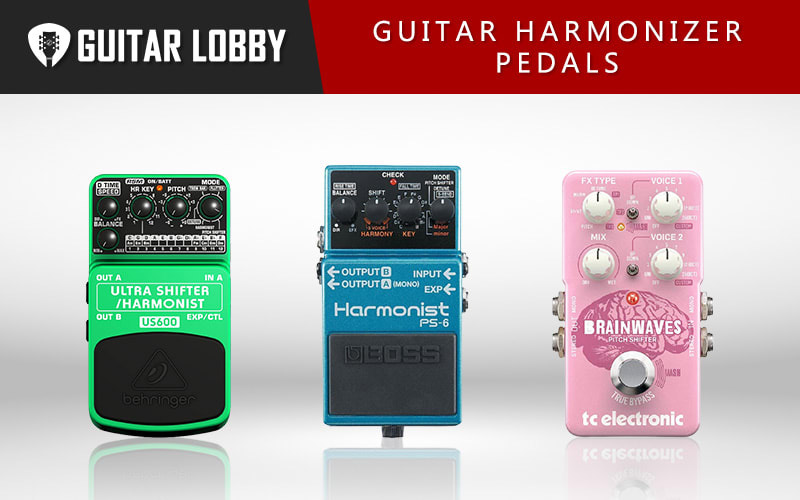
Over the years our team at Guitar Lobby has owned and tested dozens of these pedals, and in the rest of this comprehensive guide, we’ll explore the best guitar harmonizer pedals at each price point and take a look at what makes this pitch-modulation effect so intriguing.
| Name of Product | Image of Product | Description | Price Range | Full Review |
|---|---|---|---|---|
| 1. TC Electronic Quintessence (Best Overall) | 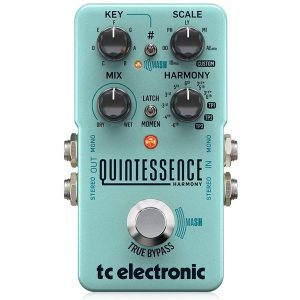 | Type: Digital Effects: Harmonizer | $210 | Read Full Review Below |
| 2. BOSS PS-6 (Best Value) | 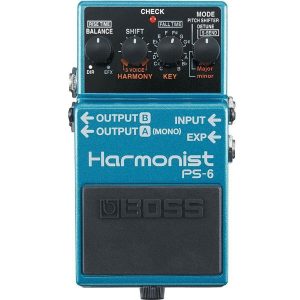 | Type: Digital Effects: Harmonizer | $240 | Read Full Review Below |
| 3. TC Electronic Brainwaves (Best Under $150) | 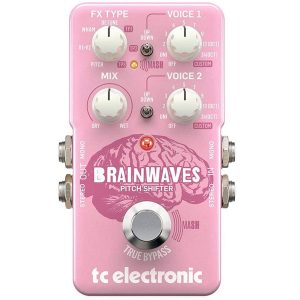 | Type: Digital Effects: Harmonizer, Pitch Shifter, Octave-Shifter | $145 | Read Full Review Below |
| 4. Hotone Skyline Harmony (Best Under $100) | 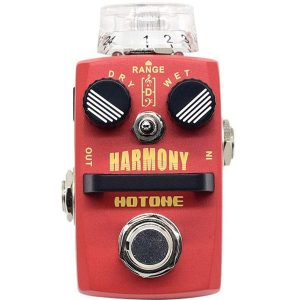 | Type: Digital Effects: Harmonizer, Pitch Shifter | $50 | Read Full Review Below |
| 5. Behringer Ultra Shifter/Harmonist US600 | 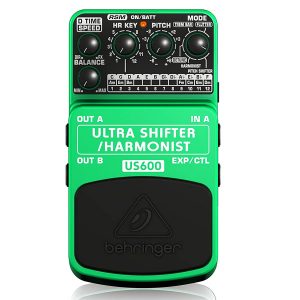 | Type: Digital Effects: Harmonizer | $120 | Read Full Review Below |
| 6. EarthQuaker Devices Organizer V2 | 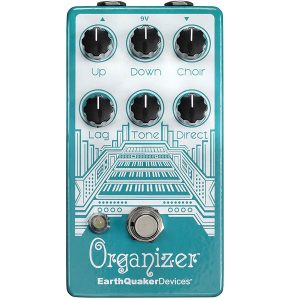 | Type: Digital Effects: Harmonizer, Octave-Shifter | $190 | Read Full Review Below |
| 7. Mooer Pure Octave | 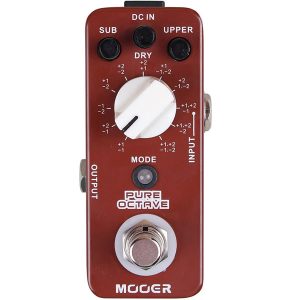 | Type: Digital Effects: Harmonizer, Octave-Shifter | $75 | Read Full Review Below |
| 8. Eventide H9 Max Harmonizer | 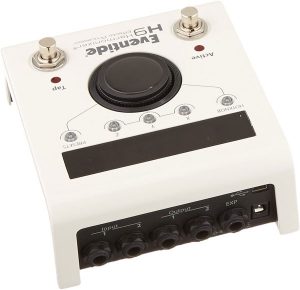 | Type: Digital Effects: Harmonizer, Multi-FX | $700 | Read Full Review Below |
| 9. EarthQuaker Devices Data Corrupter | 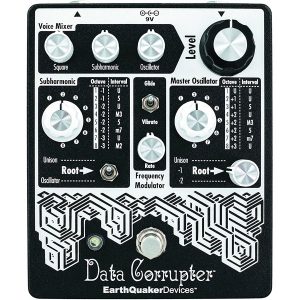 | Type: Digital Effects: Harmonizer, Guitar Synth | $230 | Read Full Review Below |
| 10. Donner Harmonic Square | 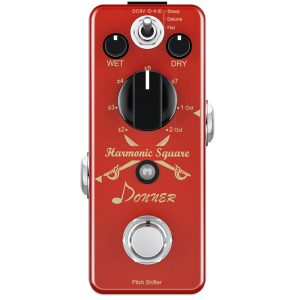 | Type: Digital Effects: Harmonizer, Octave-Shifter, Pitch Shifter | $300 | Read Full Review Below |
| 11. Caline CP-36 Big Dipper | 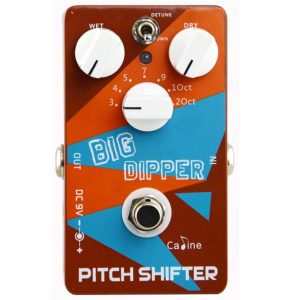 | Type: Digital Effects: Harmonizer, Octave Shifter | $85 | Read Full Review Below |
| 12. Beetronics Swarm Fuzz Harmonizer | 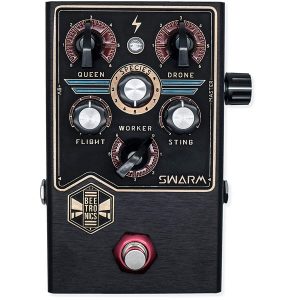 | Type: Digital Effects: Harmonizer | $250 | Read Full Review Below |
| 13. DigiTech Whammy Ricochet | 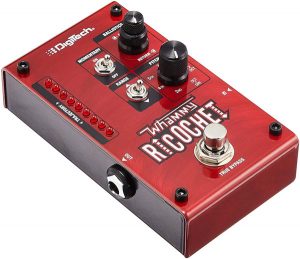 | Type: Digital Effects: Harmonizer, Pitch Shifter | $180 | Read Full Review Below |
| 14. EarthQuaker Devices Astral Destiny | 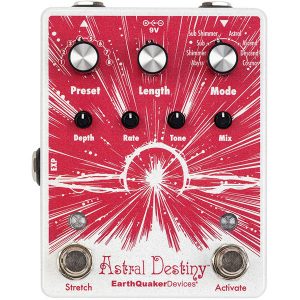 | Type: Digital Effects: Harmonizer, Octave Shifter, Reverb | $200 | Read Full Review Below |
| 15. Eventide PitchFactor Harmonizer | 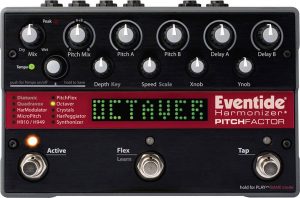 | Type: Digital Effects: Harmonizer, Octave-Shifter, Pitch Shifter | $500 | Read Full Review Below |
| 16. EarthQuaker Devices Rainbow Machine V2 | 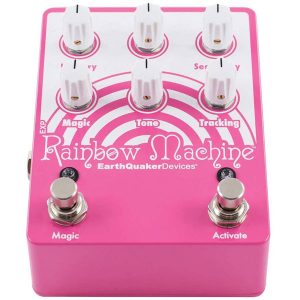 | Type: Digital Effects: Harmonizer | $75 | Read Full Review Below |
| 17. BOSS VE-2 | 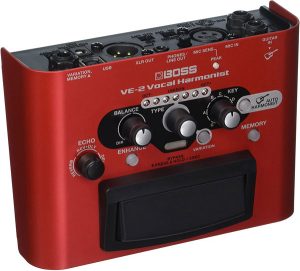 | Type: Digital Effects: Harmonizer, Multi | $450 | Read Full Review Below |
Here Are the Best Guitar Harmonizer Pedals
1. TC Electronic Quintessence (Best Overall)
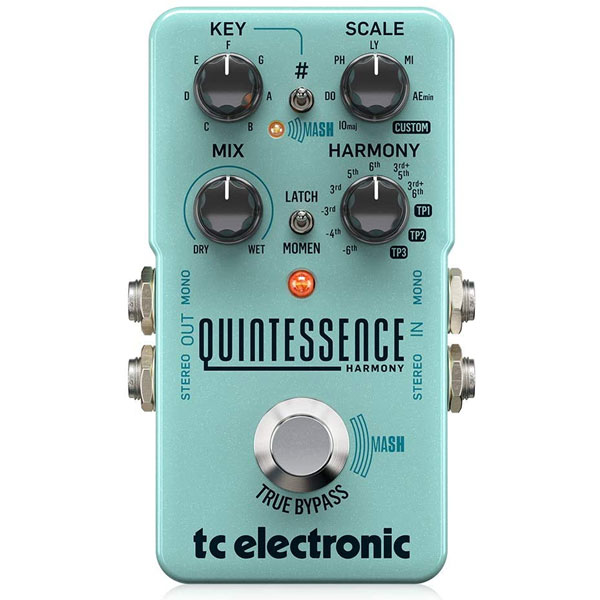
| Estimated Price | $210 |
| Type | Digital |
| Effects | Harmonizer |
| Connectivity | 2 x 6.35mm Jack Input, 2 x Output |
| Power | 9 Volts DC |
My Review: When I first got my hands on the Quintessence pedal, I could tell that this pedal offered a wide range of harmonizer-based options. I was particularly impressed by the detail of each of the four controls, which allowed me to control all aspects of the harmony effect.
After experimenting with the pedal for a little while, I noticed that the tracking of this pedal is flawless. When adding complex harmonies, for example, a major 4th in the key of A, the sound remains very natural which is a rare quality compared to your average harmonizer or pitch shifting pedal.
The quality which makes this pedal stand out amongst the crowd of harmonizer stompboxes is its undeniable versatility. I found that whether you’re using it to create harmonic overtones on your amp’s clean setting or to thicken up an overdriven riff, the Quintessence is equally as capable in either role.
The ‘Poly’ feature is perhaps the only aspect of the pedal which I feel could have been improved, but it still serves a purpose once you learn how to use it correctly. Overall I can safely say that TC Electronic has created a brilliant harmonizer pedal that is amongst the very best on the market.
Who is this best suited for: I’d strongly recommend the TC Electronic Quintessence to two types of guitarists. Firstly, those who already have a decent knowledge of music theory, harmony, and intervals will love the functionality and attention to detail of this pedal. Secondly, those who are hoping to learn more about the theoretical side of music will also find it to be valuable to their development!
Bottom Line: TC Electronic is one of the most prolific manufacturers of guitar pedals in the world. Their stompboxes are unique, and often include many more features and controls than the average pedal. The Quintessence harmonizer is another example of their expertise in this field, and it can be used to add complex harmonies to your guitar playing or to subtly beef up your tone.
2. BOSS PS-6 (Best Value)
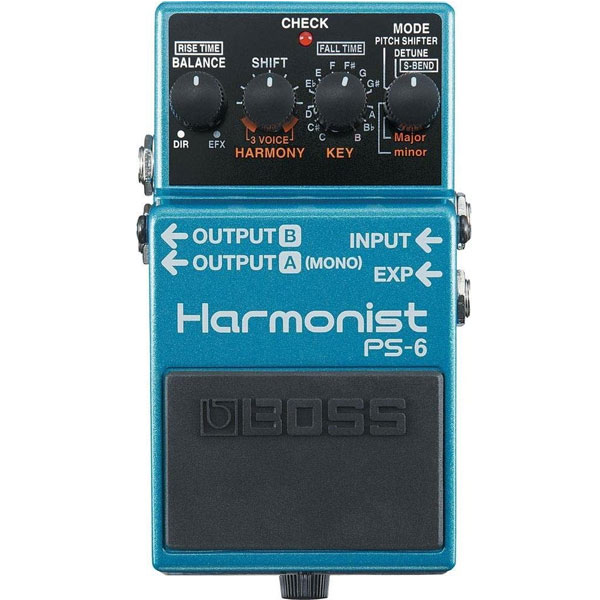
| Estimated Price | $240 |
| Type | Digital |
| Effects | Harmonizer |
| Connectivity | 2 x 6.35mm Jack Input, 2 x Outputs |
| Power | 9 Volts DC |
My Review: I’ve long been an admirer of BOSS’ diverse range of guitar pedals. They’ve created an instantly recognizable design blueprint, and all of their pedals are as roadworthy as they come. The Harmonist PS-6 is their flagship harmonizer pedal, and I couldn’t wait to experiment with its many controls and functions.
Right off the bat, it became evident to me that despite the minimalistic design of the PS-6, it offers plenty of pitch-shifting and harmonic tools for guitarists to utilize. The controls are set out in a way that makes it very easy to select the relevant key of the harmony you want to create. Additionally, I found that the major/minor selector was very useful for quickly changing the mood of the harmonies the pedal produces.
This pedal surprised me with its many unique features, perhaps the most noteworthy being the ‘S-Bend’. At first, I was unsure of this feature’s purpose, but after messing around with it for some time I found that it offers the possibility of controlling the ascent or descent of the layered harmonies from the original note played on the guitar.
Who is this best suited for: Like most BOSS pedals, the harmonist PS-6 is the type of device that all guitarists will find useful. However, I’d recommend it specifically to those who want to combine the harmonizer and pitch shifter effects with other pedals in their signal chain, as it blends very nicely with a range of other effects.
Bottom Line: The BOSS Harmonist affords you the freedom to quickly select your desired key, and to control the nature of the overtones it produces. By adjusting the four controls on the pedal you can create everything from subtle 3rd or 5th harmonies to dissonant drones. Dollar for dollar, I’d say this is the best harmonizer pedal for guitars out there.
3. TC Electronic Brainwaves (Best Under $150)
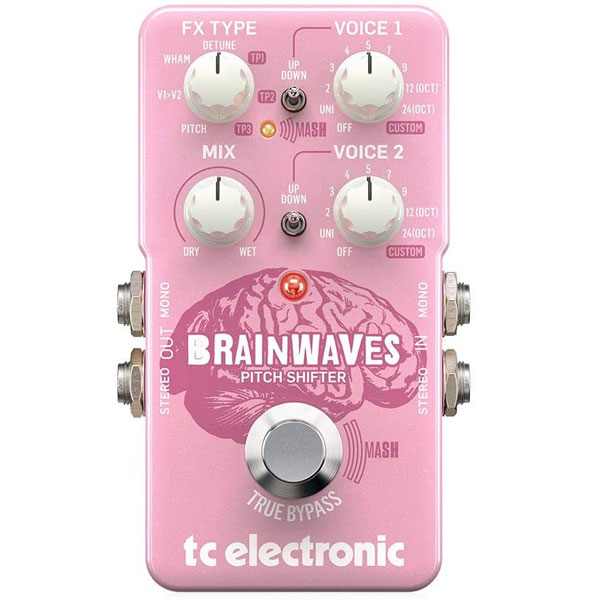
| Estimated Price | $145 |
| Type | Digital |
| Effects | Harmonizer, Pitch Shifter, Octave-Shifter |
| Connectivity | 2 x 6.35mm Jack Input, 2 x Output |
| Power | 9 Volts DC |
My Review: I was originally drawn to the Brainwaves pedal by TC Electronic due to its flamboyant, eye-catching aesthetical design. Like all TC Electronic pedals, it has a unique visual quality which I found intriguing.
If you like to create unorthodox-sounding tones, you’ll love the unique effects offered by this pedal. I like how it combines pitch-shifting with harmonizer-like qualities, and it also makes a great alternative to a whammy pedal.
The thing that makes this TC Electronic harmonizer stand out is its ability to handle chords. Compared to most other pitch-modulating pedals, it tracks incredibly smoothly when multiple notes are played. I found that by using the two voice controls I was able to blend octaves and other intervals to create thick-sounding textures ideal for melodies and chord patterns.
Who is this best suited for: The TC Electronic Brainwaves pedal is best suited for guitarists who like to experiment to create their unique tones. With the TonePrint programming and customizable presets, you have plenty of freedom to shape sounds to your liking.
Bottom Line: A multi-functional pedal, the Brainwaves by TC Electronic combines the roles of a whammy device, harmonizer, and pitch shifter. It contains two voices that can be blended or used alone, and the TonePrint editor allows you to set up and store your own presets.
4. Hotone Skyline Harmony (Best Under $100)
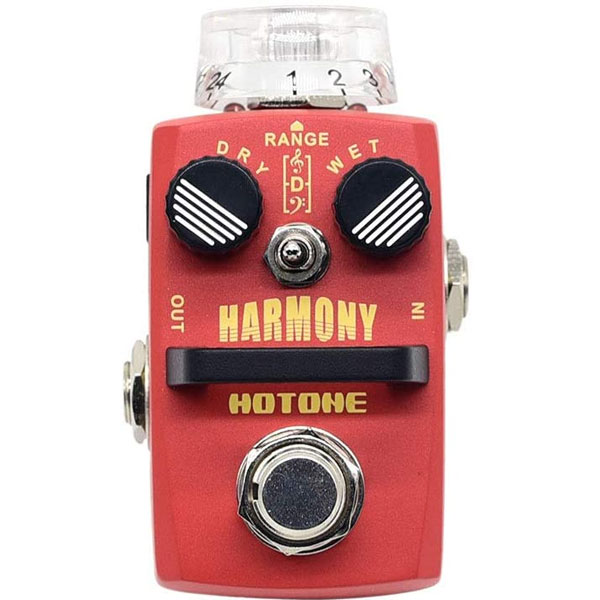
| Estimated Price | $50 |
| Type | Digital |
| Effects | Harmonizer, Pitch Shifter |
| Connectivity | 1 x 6.35mm Jack Input, 1 x Output |
| Power | 9 Volts DC |
My Review: Hotone is a relatively newly established pedal manufacturer, and their quick rise to the top tier of the industry has been very impressive indeed. The Skyline Harmony is amongst the smallest pedals featured on our list, but I learned that its size is not an indicator of its capabilities.
Operating this harmonizer pedal couldn’t be any more straightforward. The two rotary knobs are used to decide the blend between the dry signal of the guitar and the wet signal of the pedal. When I began to play around with the central selector switch, the pedal showed its versatility.
In default mode, I discovered that the Skyline Harmony simply adds a perfect 5th to whatever notes I played on the guitar. This mode is great for adding depth to solos, and for metal-style shredding. When I tweaked the position of the switch to ‘Pitch Shift Mode’, I was able to add an interval of semitones to my guitar’s original notes.
Finally, I found the ‘Detune’ mode to be very interesting and fun to use. When this mode is engaged, the original notes are played back slightly out of tune, at intervals of cents rather than semitones. The polyphonic nature of the pedal ensures that the notes or chords you play still sound thick and immersive.
Who is this best suited for: Due to the compact size and affordability of the Hotone Skyline Harmony, I’d recommend this pedal to guitarists who are trying to build up their pedalboard on a budget, or perhaps need to save as much space as possible for other more bulky effects.
Bottom Line: The Hotone Harmony pedal may be one of the most affordable devices on this list, but it is built to a very high standard. With true bypass switching and a robust zinc alloy chassis, the pedal is roadworthy and reliable.
Popular Related Article: Top 17 Guitar Octave Pedals
5. Behringer Ultra Shifter/Harmonist US600
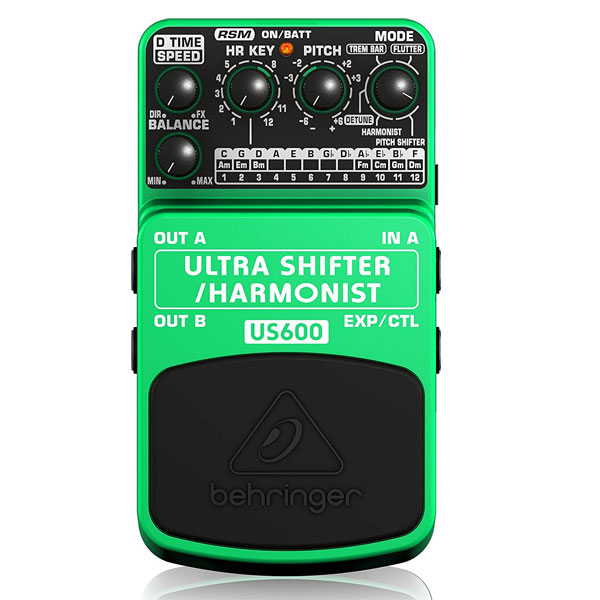
| Estimated Price | $120 |
| Type | Digital |
| Effects | Harmonizer |
| Connectivity | 2 x 6.35mm Jack Input, 2 x Output |
| Power | 9 Volts DC |
My Review: Behringer is renowned for producing affordable pedals, which are often based on the designs of more expensive models. The US600 Ultra Shifter/Harmonizer is essentially a clone of the aforementioned BOSS Harmonizer, and it comes very close to the high standard set by that pedal.
Compared to previous Ultra Shifter models, this newly updated edition contains an improved algorithm so that the tracking is more responsive. I was pleased to discover that Behringer had made this improvement, as the older versions tended to lag a little especially when multiple notes were played simultaneously.
I was particularly impressed by the usefulness of the US600 for practicing alone. In addition to adding harmonies and textures to your guitar playing, you can use the pedal to create drones with long decays, and solo over the top of them or use them to compose melodies.
Who is this best suited for: Behringer pedals are suitable for guitarists who perhaps don’t want to spend a lot of money on individual effects, but still require access to high-quality tone-shaping options.
Bottom Line: With improved tracking and the ability to handle up to three notes at once, the Behringer Ultra Shifter/Harmonizer is a multi-faceted pedal at competes with more expensive options in its category. It’s very easy to operate and can be used on a clean tone or alongside other effects.
6. EarthQuaker Devices Organizer V2
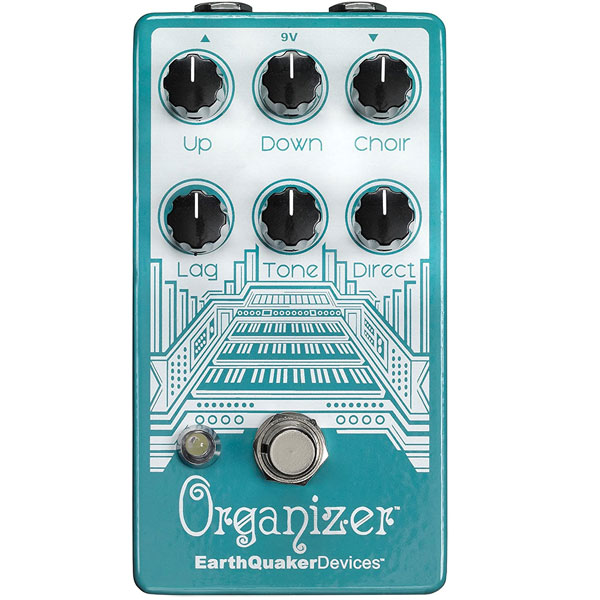
| Estimated Price | $190 |
| Type | Digital |
| Effects | Harmonizer, Octave-Shifter |
| Connectivity | 1 x 6.35mm Jack Input,1 x Output |
| Power | 9 Volts DC |
My Review: At Guitar Lobby, we’re always on the lookout for weird and wonderful effects pedals. The second edition of EarthQuaker Devices’ Organizer is unlike any other harmonizer pedal and is designed to reproduce the tones of an organ-like instrument.
One of the key aspects of an organ’s sound is the blend of harmonies and overtones which make up a chord. I found that the Organizer V2 can produce this distinctive tone, and by using the six controls on the face of the pedal, you can adjust the harmonies to suit your requirements.
After testing many of EarthQuaker Devices’ pedals, I’m constantly impressed by the way they manage to design them in such a simple and easy-to-use way, whilst leaving the door open for complex tonal and dynamic effects. The Organizer V2 provides guitarists with endless possibilities for layering their tone with octaves and harmonies.
Who is this best suited for: If you enjoy the sound of an organ, the Organizer V2 by EarthQuaker Devices allows you to bring those harmonically rich tones onto your pedalboard. This device predominantly focuses on adding octave notes to the dry signal, so if you’re looking for more complex harmonies it may be better to choose a different option.
Bottom Line: Housed in a durable metal chassis and with true bypass switching for maximum signal integrity, the Organizer V2 is a unique harmonizer pedal for guitar. With controls including Choir, Tone, and Lag, it allows you to create organ-inspired harmonies and blend them with your guitar’s dry signal.
Popular Related Articles: 17 Incredible Vibrato Pedals You Need To Try
7. Mooer Pure Octave
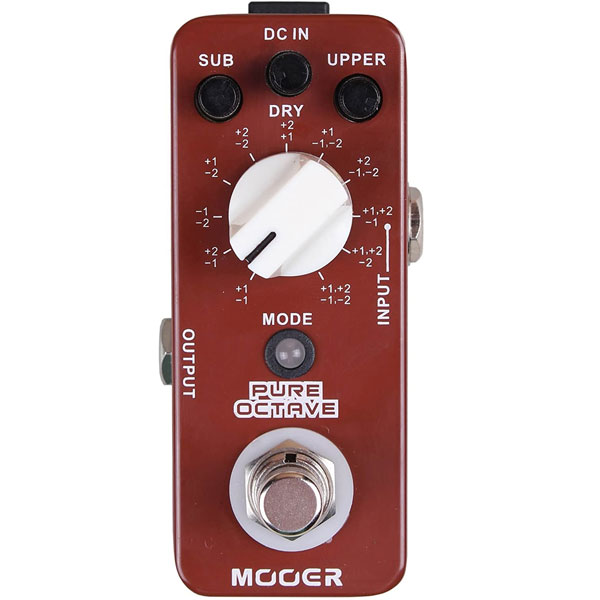
| Estimated Price | $75 |
| Type | Digital |
| Effects | Harmonizer, Octave-Shifter |
| Connectivity | 1 x 6.35mm Jack Input, 1 x XLR Mic Input, 1 x Output |
| Power | 9 Volts DC |
My Review: Although this minute Mooer stompbox is predominantly an octave-shifter pedal, it also performs like a harmonizer in several ways. The first thing that caught my attention about this pedal was its simple, minimalistic design and control layouts.
The three small-sized controls across the top layer of the Pure Octave pedal are responsible for the conventional octave-shifting effect. Moreover, after analyzing the functions of the controls I discovered that you can blend the trio to essentially build your harmonies one layer at a time.
Then, once you’ve found the right balance between the sub-octave, dry and upper-octave notes, you can use the larger rotary control to change the harmonic content within the group. I was very impressed with the clean tone of this Mooer pedal, which remained even when dissonant harmonies are added into the mix.
Who is this best suited for: The Mooer Pure Octave is a solid choice for guitarists who want an octave-shifter in addition to a harmonizer pedal. This device performs both roles very capably and therefore can save you on cost and space.
Bottom Line: Don’t let the seemingly simple design of the Mooer Pure Octave deceive you – this pedal can produce a range of complex tones and textures. The four controls allow you to deliberately create chord-like blends of notes and adjust the pitch using the semitone-moving parameter.
8. Eventide H9 Max Harmonizer
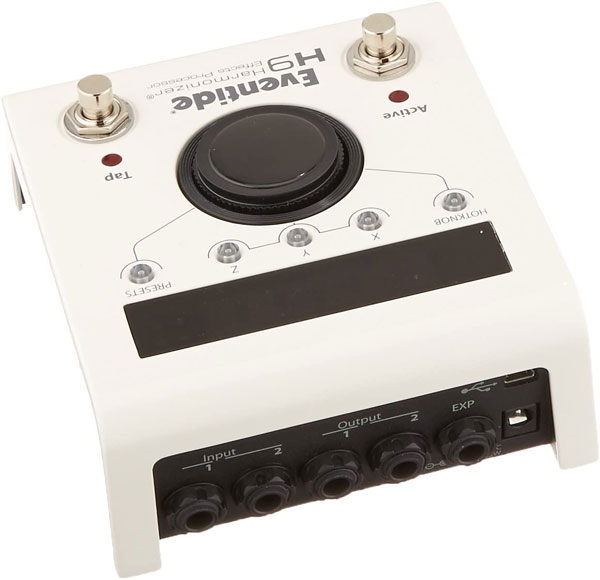
| Estimated Price | $700 |
| Type | Digital |
| Effects | Harmonizer, Multi-FX |
| Connectivity | 2 x 6.35mm Jack Input, 2 x Output |
| Power | 9 Volts DC |
My Review: Eventide has built a reputation as one of the leading producers of digital effects units, so I was very excited to test their H9 Max Harmonizer and to see how it compares to their other exceptional offerings.
I learned that the H9 is much more than a standard harmonizer device. With over 50 unique algorithms, including PitchFactor, TimeFactor, Space, and ModFactor, this pedal is capable of producing everything from ear-friendly harmonies to long-tailed reverbs and delays.
The harmonizing capabilities of the H9 are just as good as any standalone guitar harmonizer pedal. The advantage of using this device is that it opens up so many possibilities in the recording studio, thanks to its extensive bank of presets and editing tools.
Who is this best suited for: If you’re in the beginning stages of assembling your pedalboard and intend to purchase a selection of effects in the near future, the Eventide H9 Max Harmonizer may be the perfect choice for you. In addition to being a high-quality harmonizer pedal, it includes all of the staple effects you’ll need to transform your guitar’s tone.
Bottom Line: Packed with 99 onboard presets, over 50 algorithms, a plethora of reverbs, delays and modulation effects, and a range of tools for live performance and recording, the H9 by Eventide is one of the most comprehensive pedals money can buy.
Popular Related Article: 17 Must Hear Guitar Flanger Pedals
9. EarthQuaker Devices Data Corrupter
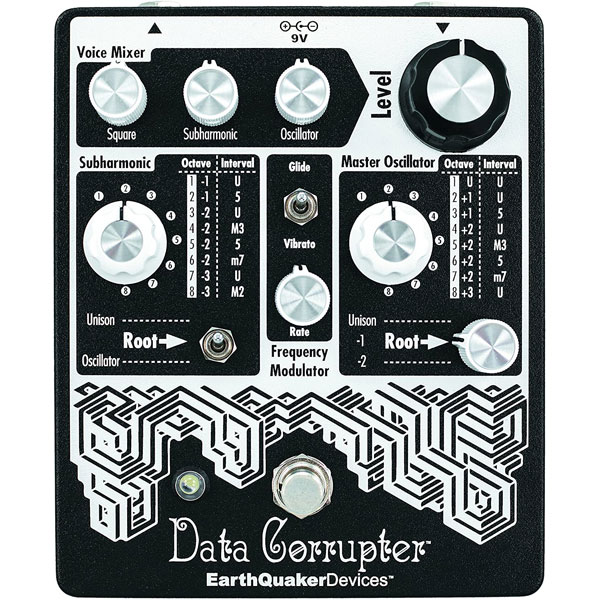
| Estimated Price | $230 |
| Type | Digital |
| Effects | Harmonizer, Guitar Synth |
| Connectivity | 1 x 6.35mm Jack Input, 1 x Output |
| Power | 9 Volts DC |
My Review: My first impression of the Data Corrupter by EarthQuaker Devices led me to believe that it is a complex pedal. It features an array of rotary knobs, switches, and numbers displayed across its chassis. In reality, it is quite a complicated device, however, each of the controls has been included to create a unique, multi-functional pedal.
The Data Corrupter combines synth-like modulation with the capabilities of a harmonizer pedal. I was impressed by its ability to produce complex harmonics which reach three octaves up or down from the dry note played on your guitar.
EarthQuaker Devices has included a few features and mechanisms to ensure that this pedal sounds crisp and authentic. Firstly, the all-analog signal path sets the tone for the sound quality of the device. Then there’s the subharmonic switch, which allows you to create interesting harmonies to accompany the dry signal. These features make the Data Corrupter unique amongst the majority of guitar harmonizer pedals.
Who is this best suited for: The Data Corrupter is a great choice for guitarists who incorporate electronic music elements into their songs. It has the potential to transform your guitar’s signal into a blend of synth tones and modulation effects, whilst adding complex harmonies to the output.
Bottom Line: EarthQuaker Devices once again prove that they are one o the most innovative pedal producers out there with the intriguing Data Corrupter monophonic harmonizer. With its fully analog signal path and range of adjustable parameters, you can create an obscure lead guitar tone using this pedal.
10. Donner Harmonic Square
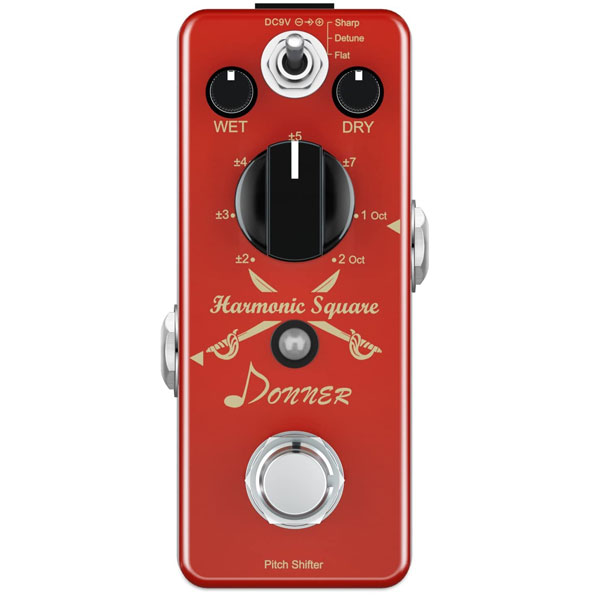
| Estimated Price | $300 |
| Type | Digital |
| Effects | Harmonizer, Octave-Shifter, Pitch Shifter |
| Connectivity | 1 x 6.35mm Jack Input, 1 x Output |
| Power | 9 Volts DC |
My Review: Since Donner burst onto the scene in 2012, I’ve watched with a keen eye as they rapidly evolved into one of the leading affordable guitar pedal producers. The Harmonic Square is their flagship harmonizer and an octave pedal.
I’ve tested several Donner stompboxes in the past, and have found that they each have one quality in common – ease of use. The Harmonic Square continues this trend. The large rotary control in the center of the pedal is used to adjust the interval between the dry note of the guitar and the reproduced harmony.
Once you’ve selected the interval from the seven preset modes, you can then use the two smaller controls to blend the wet and dry signals and create the ideal balance. The toggle switch at the top of the pedal is another feature I found useful, especially when it is set to ‘detune’ mode. This makes the harmonizer effect sound a little off-center and is ideal for building tension.
Who is this best suited for: Donner’s pedals are suitable for musicians who are looking to save on cost without compromising on quality. The Harmonic Square is very easy to use, so you don’t need a wealth of experience with effects to benefit from this harmonizer pedal.
Bottom Line: Straightforward, robust, and versatile, the Donner Harmonic Square combines the functions of a standard octave shifter pedal and a harmonizer. Each of the controls on the pedal plays a vital role in the overall shaping of the harmonizer effect, and true bypass switching ensures maximum signal strength. While it’s a little more expensive than most of the pedals on this list, it’s easily one of the best guitar harmonizer pedals out there.
11. Caline CP-36 Big Dipper
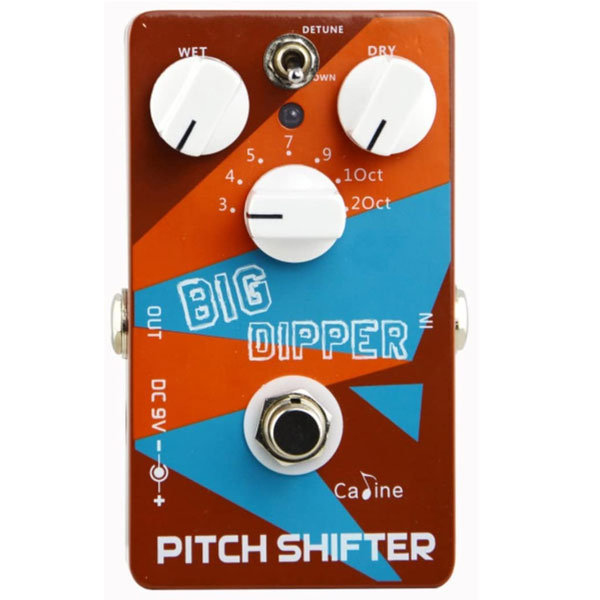
| Estimated Price | $85 |
| Type | Digital |
| Effects | Harmonizer, Octave Shifter |
| Connectivity | 1 x 6.35mm Jack Input, 1 x Output |
| Power | 9 Volts DC |
My Review: The CP-36 Big Dipper originally caught my attention due to its eccentric design, but after taking a closer look at the pedal I soon realized it has more to offer than just pleasant aesthetics. I’d describe this device as being a mixture between a traditional pitch shifter, harmonizer, and octave pedal.
The three-way toggle switch positioned at the top of the pedal makes it quick and easy to jump between detune upper, and pitch-down modes. Once the desired mode is selected, you can then adjust the interval of the harmony that is produced based on the dry notes coming from your guitar.
Who is this best suited for: Affordable and very easy to use, the Caline Big Dipper is recommendable to guitarists looking for a reasonably priced harmonizer pedal. It also performs the roles of a pitch shifter and octave shifter pedal, so if you’re considering purchasing either of those, this device may interest you.
Bottom Line: Caline’s the Big Dipper makes it very easy to modulate the pitch of your guitar. With a simplistic three-knob layout and a mode switch, it doesn’t take long to strike the perfect balance between your guitar’s dry signal and the harmonies the pedal produces.
12. Beetronics Swarm Fuzz Harmonizer
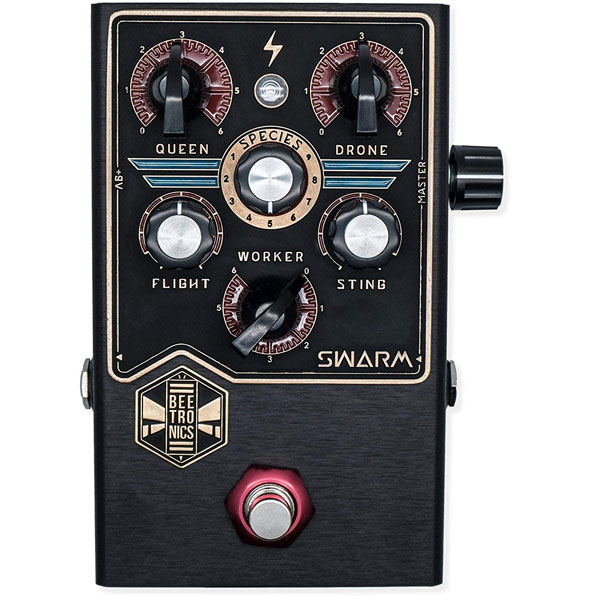
| Estimated Price | $250 |
| Type | Digital |
| Effects | Harmonizer |
| Connectivity | 1 x 6.35mm Jack Input, 1 x Output |
| Power | 9 Volts DC |
My Review: The Beetronics Swarm Fuzz Harmonizer is no ordinary guitar pedal. With an arsenal of crazy, over-the-top tones made from layers of fuzzy warmth and harmonies it is one of the most unique pedals featured on this list.
I must admit I was a little unsure about the design of this pedal at first. Each of the different fuzz and harmonizer controls is named after various types of bees, which is unusual, to say the least. However, I love the freedom that the pedal provides when you start to blend the five tones using the parameters.
Who is this best suited for: The Beetronics Swarm pedal is a suitable choice for guitarists who are looking to add a unique flavor of the harmonizer effect to their signal chain. If you’re a fan of artificial-sounding fuzz, I think you’ll find this pedal very interesting indeed.
Bottom Line: The unique Swarm Fuzz Harmonizer pedal allows you to add a range of harmonious voices to the dry notes played by your guitar. The intervals the pedal produces consist of sub and upper octaves, second, major third, minor seventh, and the fifth. Additionally, you can add fuzzy overtones to your output by using the various bee-designed controls.
13. DigiTech Whammy Ricochet
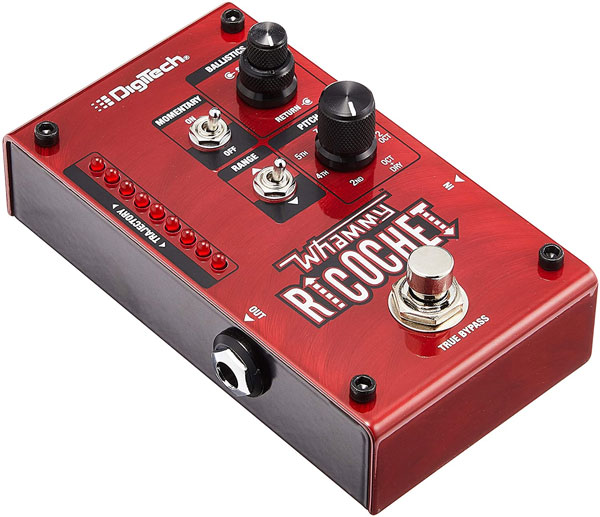
| Estimated Price | $180 |
| Type | Digital |
| Effects | Harmonizer, Pitch Shifter |
| Connectivity | 1 x 6.35mm Jack Input, 1 x Output |
| Power | 9 Volts DC |
My Review: The DigiTech Whammy originally included an expression pedal that controls the velocity and speed of the pitch-shifting effect. However, this new edition has replaced the expression pedal with more onboard controls, which makes it possible to use the device as a harmonizer.
Before testing this pedal, I was slightly skeptical because so much of the original Whammy effect came from the sudden movement of the expression pedal. I discovered that by using the momentary switch and selecting a harmony interval, I was able to combine the pitch-shifting effect with warm-sounding additional notes.
Who is this best suited for: Guitarists who want to capture the attention of the audience when playing solos will enjoy the sound created by the Whammy Ricochet. This pedal is sure to propel your guitar to the top of the mix instantly.
Bottom Line: With a selection of seven intervals ranging from a second to a double octave, the Whammy by DigiTech is a capable harmonizer pedal. This device facilitates pitch-shifted chords thanks to its polyphonic compatibility, and you can alternate between the latching and momentary modes by using the footswitch.
14. EarthQuaker Devices Astral Destiny
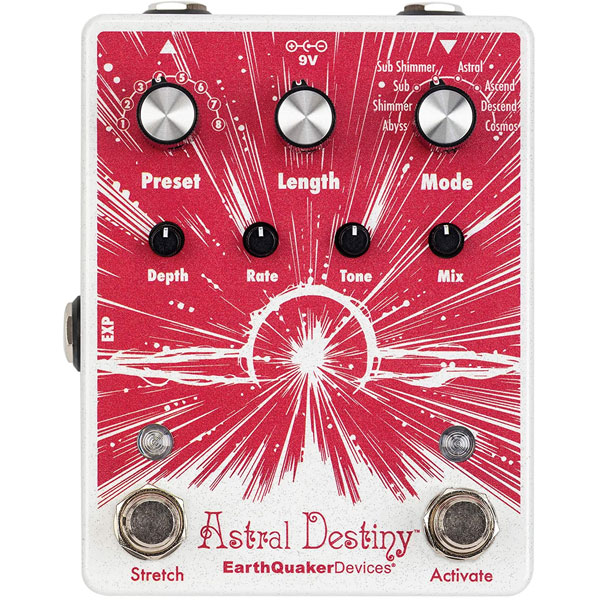
| Estimated Price | $200 |
| Type | Digital |
| Effects | Harmonizer, Octave Shifter, Reverb |
| Connectivity | 1 x 6.35mm Jack Input, 1 x Output |
| Power | 9 Volts DC |
My Review: When it comes to modulation effects, EarthQuaker Devices are certainly the leaders of the pack. The Astral Destiny is a unique pedal that allows you to harmonize with the original notes played on your guitar, by adding long-tailed reverbs and octave-shifted textures to the dry signal.
Within this pedal’s capabilities, you will find a total of eight distinctive reverb types. Each of these presets adds a new type of pitch-based modulation in addition to spacey reverb. For example, ‘Ascend’ and ‘Descend’ modes cause the reverberated notes to bend upwards or downwards respectively, creating a harmony that is in motion.
Who is this best suited for: Pysch-rock and ambient guitarists are very likely to fall in love with the unique blend of reverberated tones and harmonizing that the Astral Destiny pedal produces.
Bottom Line: With eight presets, an intuitive layout, and several adjustable parameters, the Astral Destiny is another reminder of EarthQuaker Devices’ ability to create unique stompboxes. This pedal creates an array of dreamy reverb tones mixed with soft harmonic textures.
15. Eventide PitchFactor Harmonizer
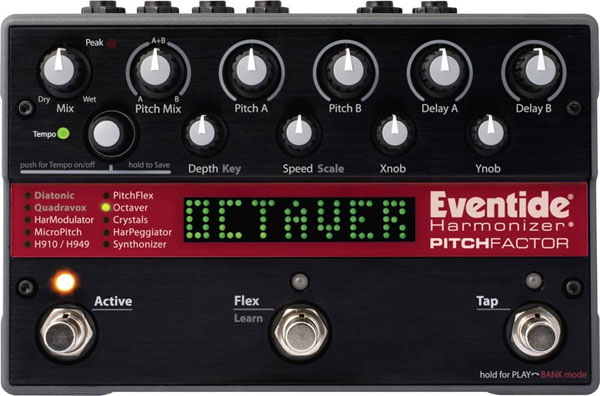
| Estimated Price | $500 |
| Type | Digital |
| Effects | Harmonizer, Octave-Shifter, Pitch Shifter |
| Connectivity | 2 x 6.35mm Jack Input, 2 x Output |
| Power | 9 Volts DC |
My Review: The PitchFactor Harmonizer by Eventide is a comprehensive guitar pedal that opens up a new realm of possibilities. The first thing I noticed about this guitar harmonizer pedal was how durable and solidly built it is, but what impressed me was its sonic qualities.
Eventide is renowned for its high-end, advanced algorithms. The PitchFactor Harmonizer comes with MIDI and USB connectivity, making it a valuable tool in the recording studio and on the stage. In terms of the harmonizer effect, I liked the vast range of intervals and tones that can be added to the dry signal of the guitar.
Who is this best suited for: If you don’t mind spending a little extra, the Eventide PitchFactor Harmonizer is one of the most sophisticated pedals money can buy. It also includes high-quality delays and other effects, so if you’re looking for an all-in-one modulation hub this could be the perfect solution.
Bottom Line: Designed to provide guitarists with all of the modulation effects they could need, the PitchFactor Harmonizer is a powerful device. It contains a range of rhythmic tools and tonal harmonies, in addition to adjustable controls for tweaking the speed and other characteristics of the chosen effect.
16. EarthQuaker Devices Rainbow Machine V2
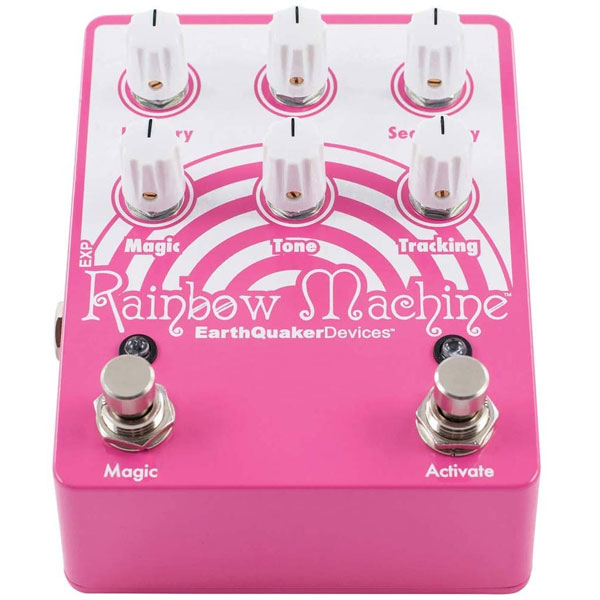
| Estimated Price | $75 |
| Type | Digital |
| Effects | Harmonizer |
| Connectivity | 1 x 6.35mm Jack Input, 1 x Output |
| Power | 9 Volts DC |
My Review: The Rainbow Machine pushes the boundaries of pitch-shifting in a way that only EarthQuaker Devices are capable of. This eccentrically designed harmonizer pedal makes use of fast-tracking and internal processing to add synthetic, strange-sounding overtones to your dry guitar’s signal.
By adjusting the pitch control, you can tweak the intensity of the harmony layers that the pedal creates. The polyphonic capabilities of the pedal make it compatible with both single notes and chords.
Who is this best suited for EarthQuaker Devices’ Rainbow Machine V2 is best suited for guitarists who want to add strange and unique-sounding harmonies to their guitar tracks, both on stage and in the studio.
Bottom Line: With its polyphonic pitch shifting, thick double-tracking and warbly chorus, the Rainbow Machine by EarthQuaker Devices lives up to its colorful name. This pedal is robustly built and utilizes true bypass for silent switching.
17. BOSS VE-2

| Estimated Price | $450 |
| Type | Digital |
| Effects | Harmonizer, Multi-FX |
| Connectivity | 2 x 6.35mm Jack Input, 2 x Output |
| Power | 9 Volts DC |
My Review: BOSS’ exceptional VE-2 is technically a harmonizer for vocalists, but I’ve included it on this list because it can also be used with electric guitar. This pedal is a brilliant tool to have as part of your rig, both for recording and performing live.
The VE-2 adds complex harmonies to vocal and guitar tracks using an ultra-fast processor. Additionally, it also includes reverb and delay effects, and the note recognition of this pedal is highly accurate. It can be easily hooked up to a computer via USB so that you can record your ideas into your chosen DAW.
Who is this best suited for: The BOSS VE-2 is suitable for musicians who combine guitar playing with singing. This vocal-centered pedal is a great tool for composition, as it creates complex harmony tracks to accompany your voice or guitar melodies.
Bottom Line: Although the VE-2 is designed predominantly for vocals, it has a guitar cable input so that singers can hook up their instrument and enjoy the wide range of effects that the pedal can produce.
The Ultimate Guitar Harmonizer Pedal Guide
Guitar harmonizer pedals are closely associated with octave and pitch-shift devices, but several key differences make these pedals unique. They allow guitarists to thicken up their melodies and riffs, or add unconventional textures to chord patterns.
What is a Harmonizer Pedal?
To understand the basic principle of guitar harmonizer pedals, we need to go back to basics and establish what the word harmony means. Harmony is a note which is played or sung at the same time as another note, creating groups of tones, or chords.
In the context of harmonizer pedals, the original note played on the guitar is accompanied by a note which is generated by the device. This synthesized harmony merges with the original note to make a new tone, and it usually responds, or moves with the notes played on the instrument.
Guitar harmonizer pedals often allow you to adjust certain aspects of the recreated harmony. The interval between the original note and the harmony is usually determined by selecting a setting on the pedal, and this gives the guitarist control over the sound of the blended tone that is created. To learn more about all the different types of guitar pedals check out this guide.
How Guitar Harmonizer Pedals Work
Harmonizer pedals work by duplicating the original signal played on a guitar and modulating the pitch to create harmony. This is the same process used by pitch shifter and octave pedals, except harmonizers, tend to move with the notes that are played and respond based on the keys and intervals the guitarist has established.
One key aspect of harmonizer guitar pedals which enables them to run smoothly is tracking. This is the process of the pedal detecting the guitar’s signal, and there are two types of tracking – analog and digital.
Analog tracking is commonly used on vintage harmonizer pedals, or those that are trying to replicate the designs used in years gone by. This type of tracking is less precise than modern digital equivalents, but some guitarists prefer the warm, slightly rough edges feel it provides.
Digital tracking is used on the vast majority of harmonizer pedals. This modern method is highly accurate, and it allows the pedal to quickly respond to the notes that are played on the guitar and create harmonies to accompany it in real-time.
Monophonic vs. Polyphonic Tracking
Moving on, another important aspect of guitar harmonizer pedals is the difference between monophonic and polyphonic tracking.
Monophonic, or ‘mono’ as it is commonly shortened to, means that the harmonizer pedal is only capable of tracking single notes or tones at a time. So if you were to play a riff that consisted of individual notes, the pedal would have no problem creating harmonies to accompany it.
Polyphonic tracking means that the harmonizer pedal is capable of also tracking multiple notes simultaneously. So if you played a chord sequence, the polyphonic tracking would enable the pedal to create harmonies of the grouped notes as well as the single notes.
One of the reasons that the majority of pitch shifter and harmonizer pedals are digital rather than analog is because the latter type of pedal cannot be polyphonic. This means that when chords or grouped notes are played, the tracking gets overwhelmed and the effect becomes very messy.
Common Controls
Guitar harmonizer pedals vary in terms of the controls and parameters they feature. Some are designed more simplistically, while others use complex digital processors to allow the musician to create complex harmonies to accompany their riffs, melodies, and chords.
Here are the most common controls you’re likely to find on harmonizer pedals:
- Key
- Mix
- Harmony
Firstly, the ‘Key’ control allows you to determine the key of the song that you are playing on your guitar. The pedal is then able to set the duplicated notes to match that key. For example, if you chose A minor pentatonic, the pedal would know to include the notes A, B, C, D, E, F, G.
Then there’s the ‘Mix’ control which is sometimes also labeled ‘Dry/Wet’. This determines the blend between the dry signal of the guitar and the harmonies created by the pedal.
Finally, the ‘Harmony’ control, which may be called ‘Interval’, is used to select the distance in tones between the original note played on the guitar and the harmony created by the pedal. For example, you could set this to ‘5th’ to create a harmony that is 5 notes away from the root.
Where Should You Position a Harmonizer Pedal in The Signal Chain?
Harmonizer pedals belong to the pitch-shifting category, which is most commonly positioned somewhere towards the beginning of the signal chain. Dynamic pedals, like compressors, EQ and limiters come first and are then followed by distortion, overdrive, fuzz, and wah pedals.
Harmonizer pedals, pitch shifters, and octave pedals perform well when they are placed after these effects, before more transformative modulation pedals such as chorus, phasers, flangers, and then finally reverb and delay pedals.
It’s important to keep in mind that the order of your pedals in the signal chain isn’t set in stone, and you may find that you come up with the most interesting results by abandoning conventional rules and experimenting with different orders.
True Bypass vs. Buffered Harmonizer Pedals
True bypass harmonizer pedals ensure that there is no loss of signal strength even when the device is turned off. They do this by allowing the signal to flow freely through the inner circuitry of the pedal, and are most effective when cable runs which span less than 18.5 ft are being used.
Buffered harmonizer pedals, on the other hand, work by boosting the guitar’s signal to an optimal level. This ensures that as the signal travels through the chain, it doesn’t diminish in terms of its strength. It’s recommended that you begin your signal chain with a buffered pedal if possible, as this will provide an adequate boost.
How to Record a Guitar Harmonizer Pedal
One of the best things about guitar harmonizer pedals is that they are equally as useful for recordings as they are for live performances and rehearsing.
When recording your harmonizer pedal, you can either connect it directly to the input on your audio interface and capture the audio in your chosen DAW, or use a microphone that is placed in front of your amplifier speaker.
Both of these methods offer several benefits and drawbacks. Directly recording the pedal will get you the cleanest recordings possible, with no coloration added by the amplifier.
Recording the amplifier’s output using a microphone will ensure that your tone is consistent with the sound of your live guitar rig, but it will be more difficult to process the audio retrospectively due to the elements that the amp inevitably adds to the recording.
Guitar Harmonizer vs. Octave vs. Pitch Shifter
Harmonizer pedals are very closely linked to octave and pitch shifter pedals. This is because these three effects use the same tracking process to create the additional notes that accompany the dry guitar’s signal.
Octave pedals differ from harmonizers in one key area – they are designed only to recreate notes which are one or multiple octaves in distance from the original note. An octave is 12 semitones apart from the previous note, either up or down.
Pitch shifter pedals are very similar to harmonizers, except these pedals don’t generally create harmonies in real-time. They usually add a pre-determined interval to the dry signal or cause fast shifts in pitch either upwards or downwards, as is the case with a Whammy pedal.
Connectivity Options
The number of inputs and outputs included on guitar harmonizer pedals differs depending on the model and the individual specifications of the device.
If you plan to use your harmonizer pedal as a standard component in your signal chain it’s unlikely that you’ll need multiple inputs or outputs. However, if you want to use the pedal to split your signal you’ll need more than one output to facilitate this.
Some harmonizer pedals may also allow you to connect an expression pedal via an additional input. They may also offer USB connectivity for hooking the pedal up to your computer or software for downloading external presets.
Powering a Harmonizer Pedal
If you’re integrating a harmonizer pedal into your signal chain with multiple other effects, the most practical way that you can provide power to them is by using a power supply unit (PSU).
A good quality PSU allows you to supply all of your pedals with the optimal voltage they require to function properly. The unit is connected to the pedal using power cables, and these can be left in place to save you time when you need to use your pedals.
It’s also possible to power some harmonizer pedals using a 9-volt battery, however, this shouldn’t be relied on too heavily as there’s always the chance that the pedal could cut out midway through a recording taking or performance!
Summary
Guitar harmonizer pedals are great tools for creating interesting tones. These devices offer a range of ear-friendly textures, along with less conventional capabilities. I’m sure you’ll have a lot of fun experimenting with whichever harmonizer you choose to add to your pedalboard!

My name is Chris and I’ve had a passion for music and guitars for as long as I can remember. I started this website with some of my friends who are musicians, music teachers, gear heads, and music enthusiasts so we could provide high-quality guitar and music-related content.
I’ve been playing guitar since I was 13 years old and am an avid collector. Amps, pedals, guitars, bass, drums, microphones, studio, and recording gear, I love it all.
I was born and raised in Western Pennsylvania. My background is in Electrical Engineering, earning a Bachelor’s degree from Youngstown State University. With my engineering experience, I’ve developed as a designer of guitar amplifiers and effects. A true passion of mine, I’ve designed, built, and repaired a wide range of guitar amps and electronics. Here at the Guitar Lobby, our aim is to share our passion for Music and gear with the rest of the music community.

For Christopher D. Schiebel, I just read your article on 17 Best Guitar Harmonizer Pedals in 2022. I need help on using getting the correct pedal harmonies while playing a major pentatonic blues scale (let’s assume C, a song like Mustang Sally). I have the TC Electronic Quintessence and the Boss PS-6 Harmonist. What setting do I use? Looking for a +3 harmony, on the Boss I have tried the A minor setting, on the TC I have tried Key of A, scale AEmin. Or do I just use the C major scale? Help & thanks ahead of time.
Greg, pentatonic scale are the same thing as the regular scale counterpart (major 1st degree / mode or minor 6th degree / mode). Penta = 5 tonic = notes. You just take the c major scale and remove some notes (keep 1 3 4 5 7 and remove 2 and 6 from thr regular scale and you get the pentatonic). Select the major c for the major pentatonic c and it should be good.